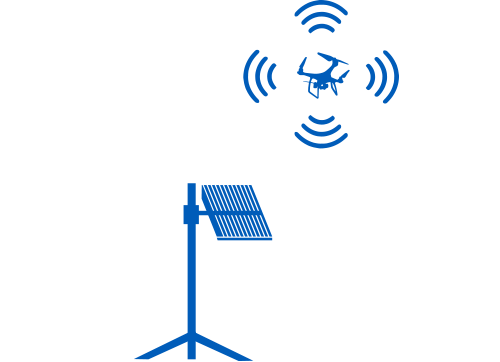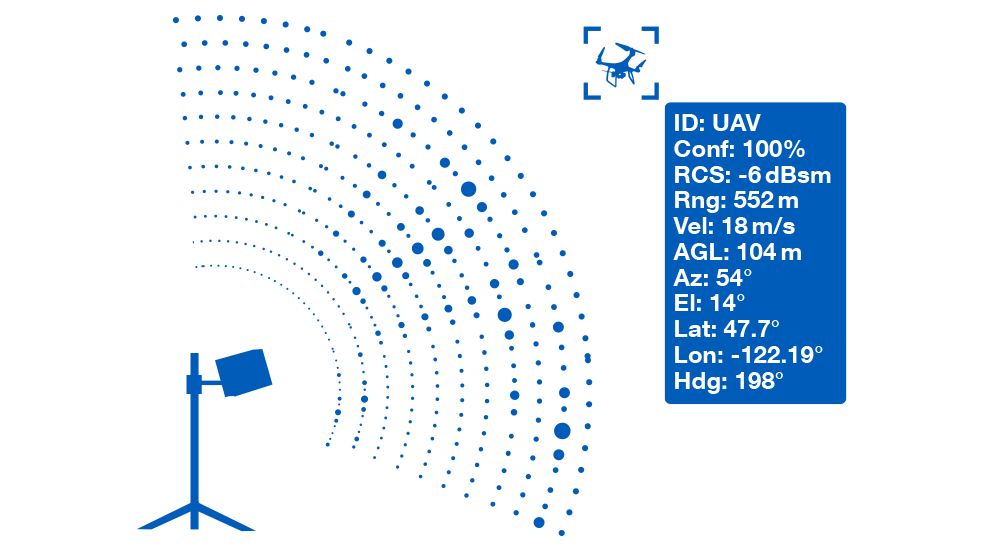PART 3
The Current and Future Role of RF Sensors
RF detection tools are sometimes confused with radar, to the point where one might be similar with or replace the other. These systems are actually quite different! The ability to accurately distinguish between the two is becoming imperative as the need for drone detection is increasingly urgent and many organizations are considering using RF sensors for their counter-drone technology.
The general rule remains: one tool is never sufficient - layered systems are the answer.
Let’s start with the differences between these two systems by looking at the method these devices use for object detection. RF sensors are passive tools that identify objects such as a drone by detecting the signal in the radio spectrum used for remote control of the drone. The RF sensor provides details about the drone itself, the signals used to communicate, and details about the operator.
Radar instead actively transmits signals in the radio spectrum. Any object located in the path of the radar signal will generate a reflected signal back to the radar. The received radar signal is rich with information about the size, shape, location, range, velocity, and orientation of the object.
While radar can offer significant information about the object, it has no means to detect or interrupt any communication to and from the drone. Since RF sensors detect the RF communication signals from the drone operator to the drone itself, it is possible to track the location of the drone operator, which can then be reported to authorities if necessary.
The Evolving Role of RF Sensors in Drone Detection Solutions
The primary reason RF sensors are currently a productive means for drone detection is a consequence of how the drone industry started and grew. One company, DJI from China, has been the dominant supplier of drones for many years, at one point having a near monopoly of the drone market. Each DJI drone sold required the customer to accept DJI’s end-user license agreement (EULA), which has fine print that provides explicit permission for DJI, and users of DJI’s AeroScope drone detection platform, to monitor communications between the operator and the drone. The method for DJI drones to be so easily identifiable can be changed by firmware updates or creative individual manipulation, and either are possible at any time.
One of the key reasons DJI was able to use this EULA is because they designed drone communications to use an unlicensed portion of the RF spectrum. While RF spectrum is a public good governed by national governments, the unlicensed portion is open for non-exclusive usage. For drones to grow in popularity, choosing unlicensed spectrum for remote operation removed usage charges or monthly costs, like one finds with mobile devices. Just as any person can find and use an app to detect Wi-Fi networks and learn the fundamental technical specifics of networks in range, any company can build and operate a sensor solution to detect, identify, and interrogate drone signals operating in unlicensed portions of the available RF spectrum. A user can always find public Wi-Fi services, but VPN services are recommended because unlicensed spectrum can be hacked.
A drone is basically a flying computer. Hacking a drone to make it less visible to RF tools or to manipulate the drone to use different spectrum, or to not use RF communications at all (optical waypoints) can be found online in any of dozens of advice videos.
Mobile device service is indeed the right comparative. Mobile devices are one user cost, like a drone is a cost, while a usage or recurring charge is required to use the network. The device can still access free Wi-Fi networks, but mobile networks require payment because the RF spectrum allocated for use is licensed to mobile network operators. The mobile network operator pays for and receives a license to use that portion of the RF spectrum from the national regulatory authority and then creates a service environment for customers through mobile phone plans. This user agreement with the service provider includes a degree of privacy that secures user communication from external intercept or interrogation without law enforcement investigations, legal proceedings, and court actions. And in nearly all statutory areas, only law enforcement agencies can use RF tools to interrogate encrypted wireless digital activity in paid-for services operating in licensed spectrum.
The mobile operator industry is working diligently to enable use of licensed spectrum for airborne objects, with the industry group 3GP issuing Release 17 in the summer of 2022. This technical architecture paves the way for mobile operators to design, build, and operate communication services for drone operators. Communication services will be a critical safety component for commercial drone operators, so redundant infrastructure, professional operations, and guarantees of privacy and service quality will create significant airspace density that traditional RF tools will not be able to detect. Additionally, drone operators will be able to consider low-Earth-orbit (LEO) satellites for very low latency communications, which are also outside the scope of RF sensors.
Even with today’s current use of unlicensed spectrum and a EULA that allows for some drone communication to be interrogated, the legality of obtaining (viewing) personally identifiable information (PII) about the drone operator or details about the drone, or the communications between the drone and operator remains unclear. And, in all cases, electronically or kinetically interfering with drone flight remains illegal in all cases.
There was a day when DJI’s AeroScope would solve every drone problem, but that was never going to last long. RF tools will continue to play a significant role in any layered system for many years. In situations where radar data clearly identifies a drone in the wrong place and RF tools detect no object, this creates a heightened level of alert and importance of maintaining optical lock while the security processes unfold. For high-risk facilities and sensitive locations, a system of multiple layered sensors with radar as the baseline is always the best approach.
Radar, at least high-performing radar, will detect, track, and classify any object that moves in the airspace, communications signature or not, and it will accurately cue optical sensors that maintain visual lock on suspect objects. Many drones will be communicative, and defense and some national security agencies will likely retain high-performance RF capabilities in the tool shed. And, just like radar and optical and some acoustic, each sensor will be used as needed for the mission and risk profile.
Now that Parts 2 and 3 have provided a better understanding of the various sensors that can be used independently or in conjunction with radar to enhance situational awareness, Part 4 will dive into the details on how to evaluate radar technology. This is important as newer threats, such as drones, create the need for low-cost, yet high-performance, commercial off-the-shelf (COTS) threat detection solutions with much different requirements than traditional ESA radar systems.



